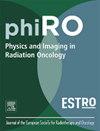Real-time target localization on 1.5 T magnetic resonance imaging linac orthogonal cine images using transfer learning
IF 3.3
Q2 ONCOLOGY
引用次数: 0
Abstract
Background and purpose
Deep learning-based tumor tracking is promising for real-time magnetic-resonance-imaging (MRI)-guided radiotherapy. We investigate the applicability of a tumor tracking model developed for 0.35 T MRI-linac sagittal cine-MRI for 1.5 T interleaved orthogonal cine-MRI and implement transfer learning to further improve its performance.
Materials and methods
We collected 3600 cine-MRI frames in sagittal, coronal and axial planes from 24 patients (validation 10, testing 14) treated on a 1.5 T MRI-linac, where two expert clinicians manually segmented target labels. A transformer-based deformation model trained on 0.35T MRI-linac images (baseline model, BL) was evaluated and used as a starting point to train patient-specific (PS) models. The Dice similarity coefficient (DSC) and the surface distance (50th and 95th percentiles, SD50%, SD95%) were used to compare the obtained target segmentations with the ground truth labels. The percentage of negative Jacobian determinant values (NegJ), accounting for the folding pixel ratio, was determined.
Results
Outperformed by all the PS models, the BL model averaged in a DSC of 0.85, SD50% of 1.9 mm, SD95% of 5.9 mm and NegJ of 0.45 % in testing. The best PS model averaged in a DSC of 0.90, SD50% of 1.3 mm, SD95% of 3.9 mm and NegJ of 0.02 % in testing.
Conclusion
We have found the 0.35 T model trained on sagittal cine-MRIs cannot be directly applied to a 1.5 T interleaved orthogonal cine-MRI system. However, PS transfer learning could improve the target tracking performance and reach an accuracy comparable to the inter-observer variability.
基于迁移学习的1.5 T磁共振直线正交电影图像实时目标定位
背景与目的基于深度学习的肿瘤跟踪在实时磁共振成像(MRI)引导放射治疗中具有广阔的应用前景。我们研究了为0.35 T mri -直线矢状线- mri开发的肿瘤跟踪模型对1.5 T交错正交线- mri的适用性,并实施迁移学习以进一步提高其性能。材料和方法我们收集了24例患者(验证10例,测试14例)在1.5 T mri直线上接受治疗的3600个矢状面、冠状面和轴向面的电影mri框架,由两名专家临床医生手动分割目标标签。对基于0.35T mri线性图像(基线模型,BL)训练的变压器变形模型进行评估,并将其作为训练患者特异性(PS)模型的起点。使用Dice相似系数(DSC)和表面距离(第50和第95百分位数,SD50%, SD95%)将获得的目标分割与地面真值标签进行比较。确定负雅可比行列式值(NegJ)占折叠像素比的百分比。结果BL模型的平均DSC为0.85,SD50%为1.9 mm, SD95%为5.9 mm, NegJ为0.45%,优于PS模型。最佳PS模型的平均DSC为0.90,SD50%为1.3 mm, SD95%为3.9 mm, NegJ为0.02%。结论矢状面mri训练的0.35 T模型不能直接应用于1.5 T交错正交的mri系统。然而,PS迁移学习可以提高目标跟踪性能,并达到与观察者间可变性相当的精度。
本文章由计算机程序翻译,如有差异,请以英文原文为准。
求助全文
约1分钟内获得全文
求助全文
来源期刊

Physics and Imaging in Radiation Oncology
Physics and Astronomy-Radiation
CiteScore
5.30
自引率
18.90%
发文量
93
审稿时长
6 weeks
 求助内容:
求助内容: 应助结果提醒方式:
应助结果提醒方式:


